Tesla Model 3: Child Safety Seats
Your Model 3 seat belts are designed for adults and larger children. You must
restrain infants and
small children in the second row seats only, and you must use a suitable child
safety seat
appropriate for the child's age, weight, and size. Warning: Never seat a child on a seat with an ACTIVE AIRBAG in front
of it. DEATH or
SERIOUS INJURY to the child can occur. Warning: Do not associate the Easy Entry setting with the driver's
profile when a child is
seated in the second row. Doing so can cause the driver's seat to push against
the child,
especially when a child is seated in a forward-facing child seat or booster
seat. Do not rely on
Model 3 to recognize or accommodate a child seated in the second row while using
this
setting Refer to the following label fitted to the sun visors. Note: The image shown below is representative only and may not be
identical to the label(s) in
your vehicle.
Choosing a Child Safety Seat All children age 12 and under should ride in the second and third row seats.
Always use a child
safety seat suitable for a young child's age and weight. The following table is
based on child
safety seat recommendations determined by the National Highway Traffic Safety
Administration
(NHTSA) in the United States
* Many child safety seats currently available allow children to ride
rear-facing using the child
safety seat's integrated 5-point harness for a longer period of time BASED UPON
SPECIFIC
HEIGHT AND WEIGHT LIMITS. Keep your child in a rear facing seat for as long as
possible.
CHECK THE CHILD SAFETY SEAT MANUFACTURER'S INSTRUCTIONS AND CAREFULLY
FOLLOW ALL INSTRUCTIONS
** ISOFIX is the international standard for attachment points for child safety
seats in passenger
cars. The system has other regional names including LATCH ("Lower Anchors and
Tethers for
Children") in the United States and LUAS ("Lower Universal Anchorage System") or
Canfix in
Canada. It has also been called the "Universal Child Safety Seat System" or
UCSSS.
*** Subject to instructions provided by the child safety seat manufacturer. Warning: Laws that govern how and where children should be carried
when traveling in a
vehicle are subject to change. It is the driver's responsibility to keep up to
date on, and
comply with, all current regulations in the region(s) where Model 3 is driven.
To check the
child passenger safety laws for states in the U.S., go to: http://www.ghsa.org/html/stateinfo/
laws/childsafety_laws.html. Warning: Do not use LATCH/Isofix/i-Size anchors with child restraint
system or booster seats
that have an integral safety belt where the combined weight of the child plus
the child
restraint system exceeds 65 lbs (29.5 kg). Seating Larger Children If a child is too large to fit into a child safety
seat, but too small to safely fit into the
standard seat belts, use a booster seat
appropriate for the child's age and size.
Carefully follow the manufacturer's
instructions to secure the booster seat. Installing Child Safety Seats There are two general methods used to install
child safety seats: Check the child safety seat manufacturer's
instructions and the table provided in this
document to determine which installation
method to use. Some child safety seats can be
installed using either method. Always follow
the child safety seat manufacturer's
instructions. First, make sure that the child safety seat is
appropriate for the weight, height, and age of
the child.
Avoid dressing the child in bulky clothing and
do not place any objects between the child
and the restraint system.
Adjust harnesses for every child, every trip.
To securely hold child safety seats, all
passenger seating positions are equipped with
an automatic locking retractor (ALR) that, by
pulling the seat belt beyond the length
needed for a typical adult occupant, locks the
belt into place until the seat belt is unbuckled
and the webbing is fully retracted. The ALR
mechanism operates as a ratchet, winding in
slack and preventing the seat belt from
extending any further until it has been
completely rewound. When installing a child
safety seat, engage the belt's automatic
locking retractor by pulling the seat belt
webbing until it is fully extended. The ALR
system engages only when the seat belt is at
its maximum extension point.
Note: An automatic locking retractor
disengages only when the seat belt is
unbuckled and fully retracted. The belt can
then be worn as a normal belt, sliding freely in and out and locking tight only
in an
emergency. Once disengaged, the belt must
be fully extended to re-engage the locking
mechanism whenever you install a child safety
seat.
Always follow the detailed instructions
provided by the child safety seat
manufacturer. General guidelines are provided
below.
Installing LATCH (ISOFIX) Child Seats Lower LATCH anchors are provided in the
second row outboard seats. The anchors are
located between the seat's back rest and rear
cushion. The exact location of each anchor is
identified by a child safety seat identification
button, illustrated below. The button is located
on the seat back, directly above its associated
anchor.
In the second row, install LATCH child safety
seats in the outboard seating positions only.
Use only a seat belt retained seat in the center
position.
To install a LATCH child safety seat, slide the
safety seat latches onto the anchor bars until
they click into place. Carefully read and follow
the instructions provided by the child safety
seat manufacturer.
Once installed, test the security of the
installation before seating a child. Attempt to
twist the child safety seat from side to side
and try to pull it away from the seat, then
check to ensure the anchors remain securely
in place. Note: Lower LATCH anchors should not be
used with child seats or booster seats that
have an integrated safety belt in situations
where the combined weight of the child plus
the child restraint is more than 65 lbs (29.5
kg). In these situations, use the safety belt
instead. If an upper tether strap is provided, attach its
hook to the anchor point located on the shelf
behind the rear seats. Note: The location of anchor points may not
be readily visible but can be found by
identifying a slice in the seat's material. Warning: Tighten upper tether straps
according to the instructions provided by
the manufacturer of the child safety seat. Warning: USE ONLY SEAT BELT
RETAINED CHILD SAFETY SEATS IN THE
CENTER SEATING POSITION.
To access an anchor point, press down on the
back of its cover.
For dual-strap tethers, position a strap on
each side of the head support.
For single-strap tethers at the outboard
seating positions, run the strap over the
outside-facing side of the head support (same
side of the head support as the seat belt
retraction mechanism).
For a single-strap tether in the center seating
position, fully lower the head support and run the strap over
the top center of the head support.
Testing a Child Safety Seat Before seating a child, always make sure the
child safety seat is not loose: Warning: Extreme hazard! Do not seat a
child on the front passenger seat even if
you are using a child safety seat. This seat
has an airbag in front of it. Although this
airbag is disabled when Model 3 detects a
lightweight passenger, do not rely on
technology to protect your child. Warning: Child restraint systems are
designed to be secured in vehicle seats
by lap belts or the lap belt portion of a
lap-shoulder belt. Children could be
endangered in a crash if their child
restraints are not properly secured in the
vehicle. Warning: According to collision statistics,
children are safer when properly
restrained in the rear seating positions
than in the front seating positions. Warning: Do not use a forward facing
child safety seat until your child weighs
over 20 lbs (9 kg) and can sit independently. Up to the age of two, a
child's spine and neck are not sufficiently
developed to avoid injury in a frontal
impact. Warning: Do not allow a baby or infant to
be held on a lap. All children should be
restrained in an appropriate child safety
seat at all times. Warning: To ensure children are safely
seated, follow all instructions provided in
this document and by the manufacturer
of the child safety seat. Warning: Children should ride in a rear
facing child safety seat using the seat's
integrated 5-point harness for as long as
possible. Warning: Do not use seat belt extenders
on a seat belt that is being used to install
a child safety seat or booster seat. Warning: When seating larger children,
make sure the child's head is supported
and the child's seat belt is properly
adjusted and fastened. The shoulder
portion of the belt must be away from the
face and neck, and the lap portion must
not be over the stomach. Warning: Never attach two child safety
seats to one anchor point. In a collision,
one anchor point may be incapable of
securing both seats. Warning: Child restraint anchors are
designed to withstand only those loads
imposed by correctly fitted child
restraints. Under no circumstances are
they to be used for adult seat belts,
harnesses, or for attaching other items or
equipment to the vehicle. Warning: Always check harnesses and
tether straps for damage and wear.
Warning: Never leave a child unattended,
even if the child is secured in a child
safety seat. Warning: Never use a child safety seat
that has been involved in a collision. Have
the seat inspected or replaced as
described in the child safety seat
manufacturer's instructions.Guidelines for Seating Children

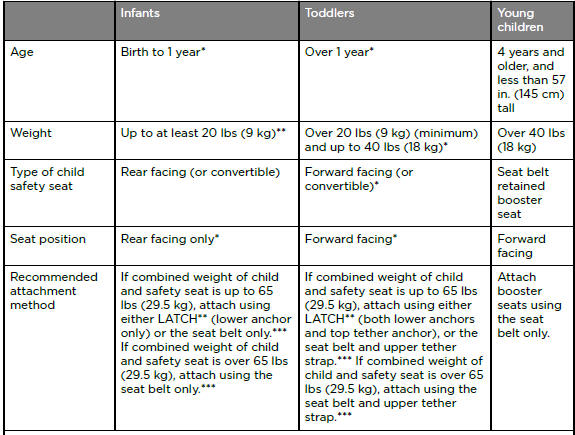
Installing Seat Belt Retained Child Seats

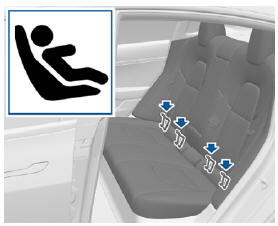
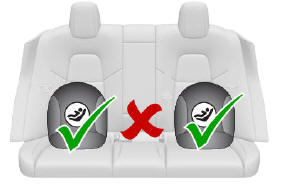
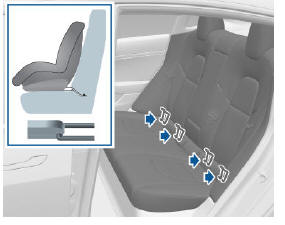
Attaching Upper Tether Straps



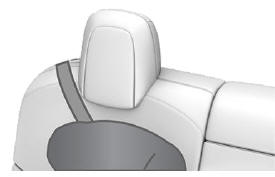
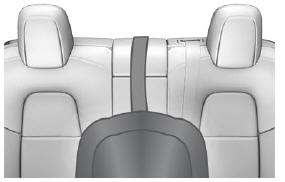
Child Safety Seat Warnings

